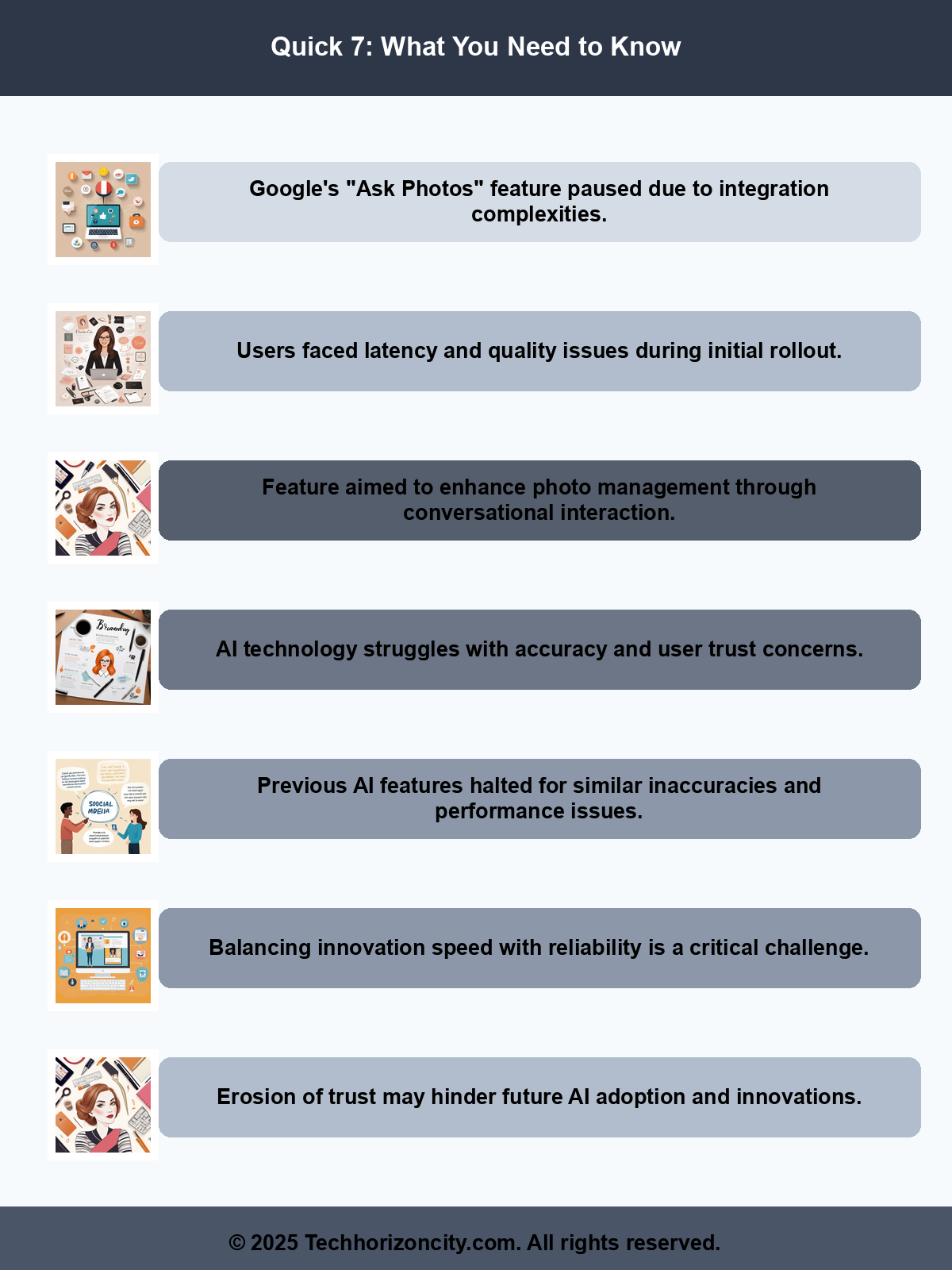Executive Summary
The recent pause on the rollout of Google’s “Ask Photos” feature underscores the complexities of integrating artificial intelligence into everyday applications. Originally introduced to enhance user interaction by allowing individuals to pose questions about their photo collections, the feature ran into significant issues related to latency, quality, and overall user experience. As Google continues to refine this AI-powered tool, the implications for the broader tech landscape are profound, raising questions about the reliability of AI systems, user trust, and the pace of innovation in an increasingly competitive market. This blog post delves into the background, implications, and future of AI-driven features in photo management and beyond.

Background Context
Artificial intelligence has become a cornerstone of contemporary technology, significantly influencing how users interact with their devices and digital content. Google first unveiled the “Ask Photos” feature during the 2024 Google I/O conference, promising a new frontier in photo management. Designed to utilize a specialized version of Google’s Gemini AI models, the feature aimed to transform mundane photo searches into a conversational experience, allowing users to ask common-sense questions about their images.
However, as the rollout began, it quickly became apparent that the feature faced critical challenges. Users reported issues with latency—sluggish response times that detracted from the overall experience—and concerns regarding the quality of the responses, which in some cases did not accurately reflect the content of the photos. This isn’t an isolated incident; Google has previously halted other AI features, such as “AI Overview” in Google Search and Gemini’s image-generation tool, due to similar inaccuracies. Notably, past incidents have included the generation of false statements about public figures and historical inaccuracies, showcasing the ongoing hurdles that AI technology must overcome.
Analysis of Implications
The decision to pause the “Ask Photos” rollout illuminates broader issues in the AI landscape. As tech companies rush to integrate advanced AI capabilities, the emphasis on speed often overshadows the critical need for accuracy and user experience. This situation raises a fundamental question: how can companies balance innovation with reliability? For Google, which has long been a leader in AI development, the stakes are high. The tech giant must not only rectify the current shortcomings of “Ask Photos” but also restore user trust in its AI capabilities.
The implications extend beyond a single feature. When users encounter inaccuracies in AI-generated responses, it can lead to skepticism towards the entire ecosystem of AI products. This erosion of trust can stymie the adoption of future innovations. Furthermore, as companies compete to release groundbreaking features, the industry may see an uptick in cautionary pauses and re-evaluations as firms grapple with the consequences of premature launches.
Industry Impact Assessment
Google’s decision to halt “Ask Photos” is emblematic of a larger trend in the tech industry where companies are reevaluating their AI strategies. As the race for AI dominance escalates, organizations must focus on ethical considerations, transparency, and the user experience. The challenges faced by Google reflect a common tension: the desire to leverage cutting-edge technology must be matched with a commitment to delivering value to users.
This incident may also catalyze other tech companies to reassess their own AI features. If Google, a pioneer in the field, is pausing significant developments, it may prompt rivals to take a more cautious approach. In an industry where public perception can shift rapidly, companies will likely prioritize accuracy and user satisfaction over the rush to introduce new capabilities.
Future Outlook
Looking ahead, we can anticipate a more measured approach to AI development across the industry. Google has indicated that a refined version of “Ask Photos” is expected to be rolled out in approximately two weeks. This timeline suggests that the company is taking user feedback seriously and is committed to enhancing the underlying technology before re-launching the feature.
Moreover, improvements to keyword search in Google Photos, allowing for exact text matches and visual matches, indicate an important shift in focus. By enhancing search functionality, Google can provide users with a more reliable experience while it works on the conversational AI aspect of photo management. This dual approach may set a new standard for user engagement, balancing the capabilities of AI with the foundational need for accuracy.
Conclusion with Key Takeaways
Google’s pause on the “Ask Photos” feature serves as a stark reminder of the challenges inherent in developing AI technologies. While the ambition to innovate is commendable, it is crucial that such advancements do not compromise user trust and experience. The tech landscape must evolve to prioritize reliability alongside creativity, ensuring that users feel confident in the capabilities of AI systems.
Key takeaways from this situation include:
- AI features require thorough testing and user feedback to ensure accuracy before release.
- Trust and user experience are paramount to the successful adoption of new technologies.
- The industry’s approach to AI may shift towards more cautious development, valuing precision over speed.
As we navigate this evolving landscape, the hope is that companies will learn from these experiences, fostering an environment where innovation and reliability coexist harmoniously.
Disclaimer: This article was independently created based on publicly available information and industry analysis. While inspired by developments reported at www.theverge.com, all content, analysis, and opinions expressed are original and do not reproduce copyrighted material.
For the original reporting, please visit: https://www.theverge.com/news/678858/google-photos-ask-photos-ai-search-rollout-pause
